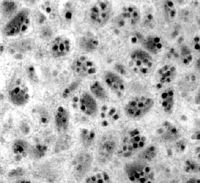Polydnaviridae
| Polydnavirus | |
|---|---|
| Virus classification | |
| Group: | Group I (dsDNA) |
| Family: | Polydnaviridae |
| Genera | |
A polydnavirus /pɒˈlɪdnəvaɪərəs/ (PDV) is a member of the family Polydnaviridae of insect viruses. There are currently 53 species in this family, divided among 2 genera. Polydnaviruses form a symbiotic relationship with parasitoid wasps (ichnoviruses occur in ichneumonid wasps species and bracoviruses in braconid wasps), but these wasps are themselves parasites of lepidoptera. Little or no sequence homology exists between BV and IV, suggesting that the two genera evolved independently.
Group: dsDNA
Viruses in Polydnaviridae are enveloped, with prolate ellipsoid and cylindrical geometries. Genomes are circular and segmented, composed of multiple segments of double-stranded, superhelical DNA packaged in capsid proteins. They are around 2.0–31kb in length.
Viral replication is nuclear. DNA-templated transcription is the method of transcription. The virus exits the host cell by nuclear pore export. Parasitoid wasps serve as hosts, but these wasps are themselves parasites of lepidoptera. The wasp injects one or more eggs into its host along with a quantity of virus. The virus and wasp are in a symbiotic relationship: expression of viral genes prevents the wasp's host's immune system from killing the wasp's injected egg and causes other physiological alterations that ultimately cause the parasitized host to die. Transmission routes are parental.
These viruses are part of a unique biological system consisting of an endoparasitic wasp (parasitoid), an insect (usually lepidopteran) larva, and the virus. The full genome of the virus is integrated into the genome of the wasp and the virus only replicates in a particular part of the ovary, called the calyx, of pupal and adult female wasps. The virus is injected along with the wasp egg into the body cavity of a lepidopteran host caterpillar and infects cells of the caterpillar. The infection does not lead to replication of new viruses, rather it affects the caterpillar's immune system. Without the virus infection, phagocytic hemocytes (blood cells) will encapsulate and kill the wasp egg but the immune suppression caused by the virus allows for survival of the wasp egg, leading to hatching and complete development of the immature wasp in the caterpillar. Additionally, genes expressed from the polydnavirus in the parasitised host alter host development and metabolism to be beneficial for the growth and survival of the parasitoid larva. Thus the virus and wasp have a symbiotic (mutualistic) relationship.
...
Wikipedia

